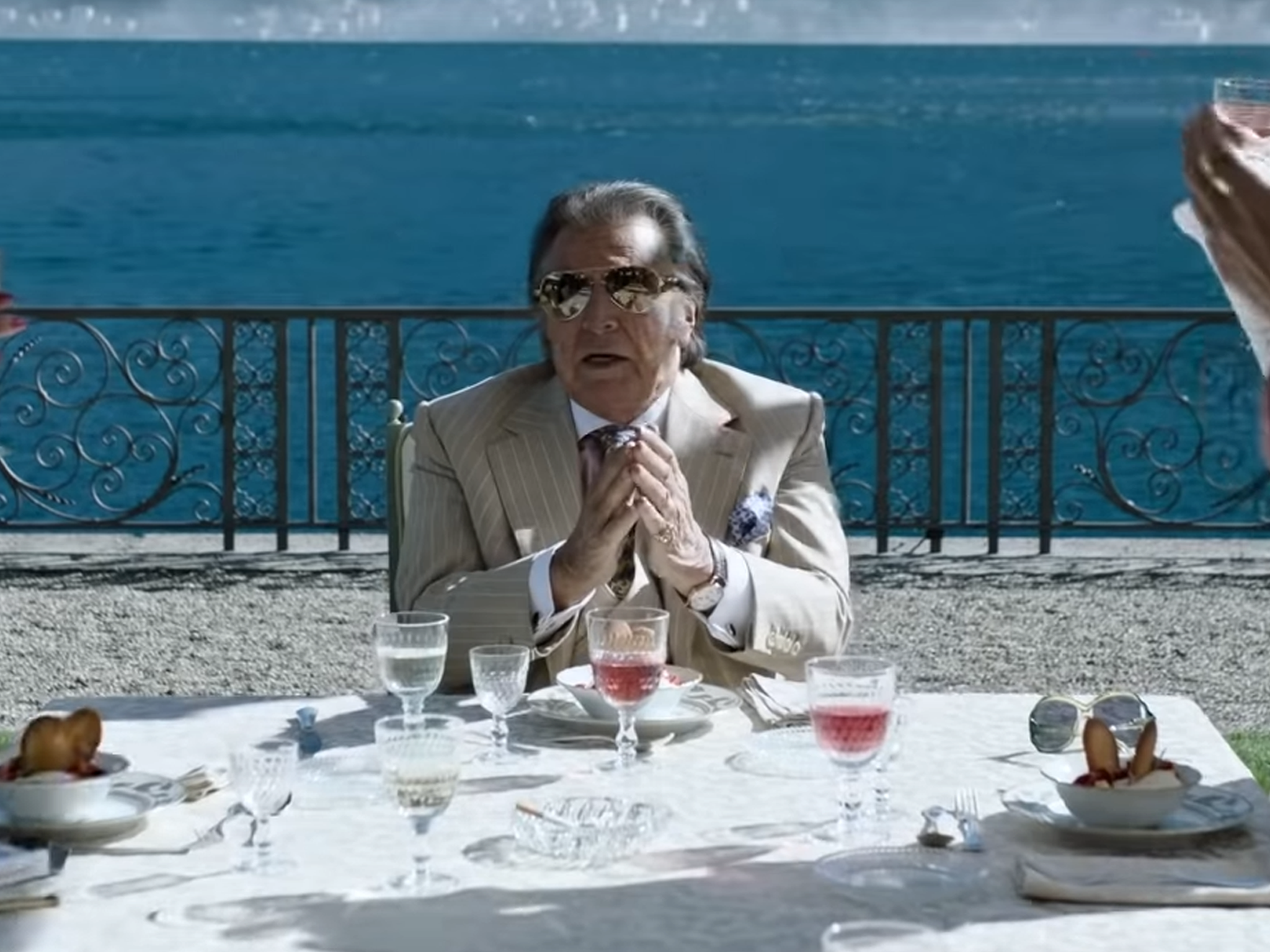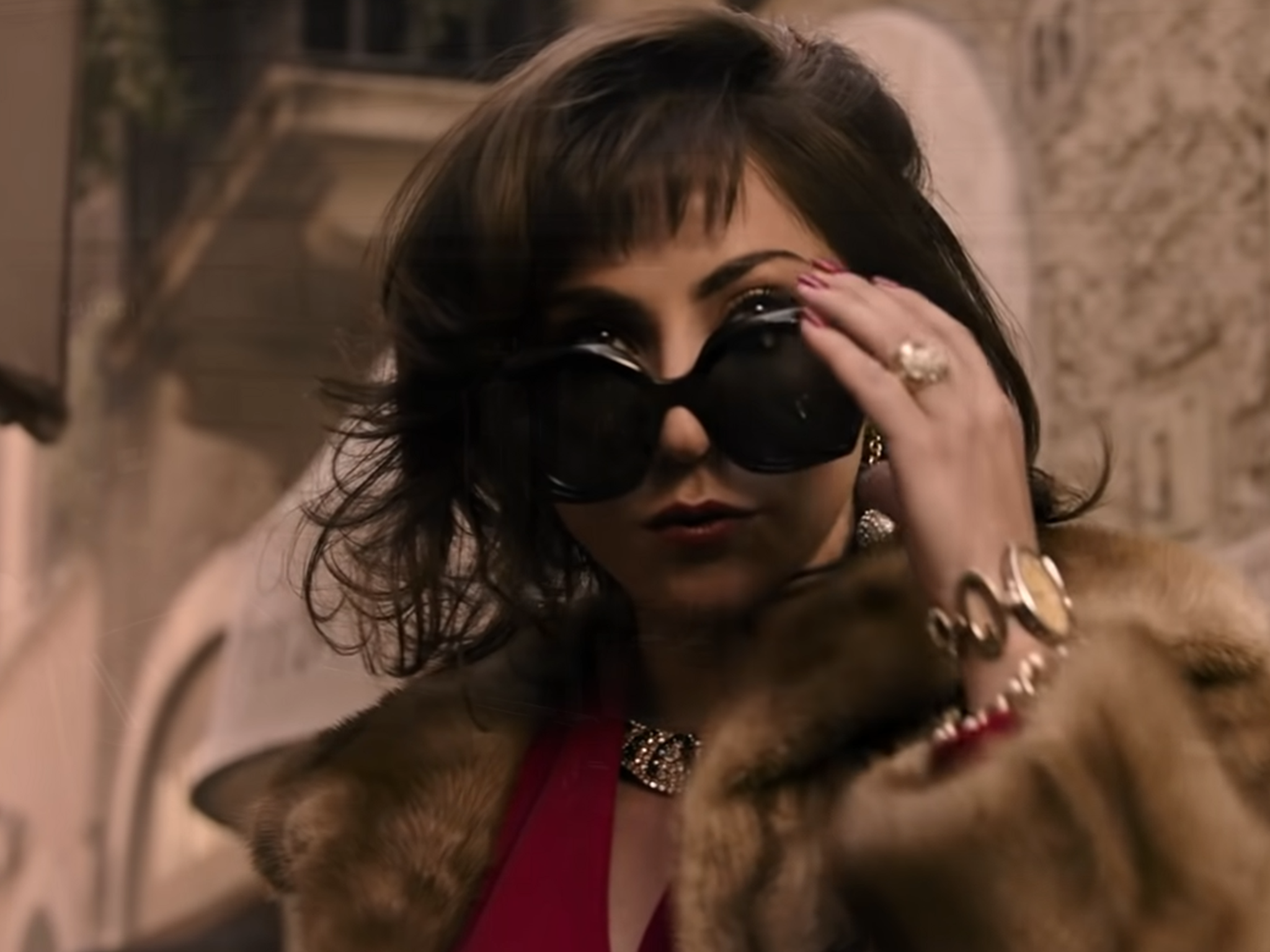Dressed to kill: Why gangster and fashion films have a lot in common
With the release of Ridley Scott’s ‘House of Gucci’, which is out in UK cinemas next month and stars Al Pacino and Lady Gaga, Geoffrey Macnab looks back at the recent wave of fashion-based dramas and documentaries that feature characters and plot lines that rival those found in gangster films

“Power… betrayal… sex… loyalty… scandal… ambition… murder.” These are the rich and spicy ingredients on offer in Ridley Scott’s latest movie, House of Gucci. Glance at the poster or look at the trailer and your automatic assumption will be that the prolific British film director has made yet another gangster movie about some Corleone-like Italian Mafia family. The presence of a very menacing-looking Al Pacino in dark glasses reinforces the sense that we are back in the realm of Mario Puzo.
In fact, House of Gucci, released in UK cinemas next month, is set not in the world of high crime but that of high fashion. The two worlds, though, are spinning closer and closer together. In the new film, Lady Gaga plays “firecracker” socialite Patrizia Reggiani, whom everybody thought looked just like Elizabeth Taylor. She married Maurizio Gucci (Adam Driver) in the early 1970s. Twenty years later, after their divorce, she ordered a hitman to kill him.
Also appearing in the film are Jeremy Irons as Maurizio’s father, the handsome, movie-loving former film star Rodolfo Gucci. Jared Leto plays his cousin, the chief designer Paolo Gucci, and Salma Hayek is Patrizia’s friend and intermediary, Pina Auriemma, who was accused of manipulating and blackmailing her. Pacino plays the family patriarch, Aldo Gucci.
According to the film trade press, the filmmakers had “unlimited access to the fashion house’s vintage archives”. That means the actors are decked out in the most luxuriant, extravagant clothes imaginable: fur coats, beautifully cut suits, and exquisite shoes. They also wear plenty of jewellery, drive sports cars, dance to Blondie in lavish discos and spend a lot of time on the ski slopes. “If you are Gucci, you need to dress the part,” Pacino’s character declares in a scene included in the trailer, sounding as if he is making a sacred vow.
When it came to murder, corruption, conspiracy and conspicuous consumption, the Guccis were right up there with the Borgias in the Renaissance era. When they weren’t busy making luxury goods, they were plotting mischief against one another. There were brawls in the boardroom, reports of family members throwing Gucci handbags at each other, rumours of gay affairs, psychic advisors who worked with potions and spells, many legal spats between family members, brothers fighting brothers, sons turning against their fathers, tax evasion, prison stints and, to cap it all, a contract killing.
Some members of the Gucci family have expressed extreme misgivings about the film. They’ve accused Scott of “stealing the identity of a family to make a profit”.
“My grandfather was a very handsome man, like all the Guccis, and very tall, blue eyes and very elegant,” Patrizia Gucci recently complained to Variety. “He is being played by Al Pacino, who is not very tall already, and this photo shows him as fat, short, with sideburns, really ugly.”
Nonetheless, the new movie is bound to be good for the fashion empire. Expect a major surge in sales of Gucci loafers and handbags in the run-up to Christmas as audiences decide they want a taste of the gaudy, gilded lifestyle depicted in Scott’s movie.
But, it’s not just about haute couture. House of Gucci is just one of a number of recent fashion-based movies, both dramas and documentaries, that feature characters and plot lines that resemble those found in gangster films. Gangsters and fashion designers often have similar roots. They’re driven, ambitious and flamboyant figures who tend to come from very humble roots. They’re dreamers and they’re rebels.
Watch the early scenes of Salvatore: Shoemaker of Dreams (2020), Luca Guadagnino’s wonderfully evocative film about the legendary designer Salvatore Ferragamo, and the parallels with The Godfather are hard to avoid. Just like Vito Corleone in Francis Ford Coppola’s crime epic, Ferragamo was an immigrant from southern Italy who then somehow made it very big indeed. He made his way to Boston and then to Hollywood where he became shoemaker to the stars. He was the underdog as hero.
“When me and my editor Walter Fassano were working on the editing of the movie, it struck us how many, let’s say, instinctual remembrances in our imagery came from The Godfather Part II,” Guadagnino acknowledged about the similarities between the stories.
Closer to the UK, Ian Bonhôte’s 2018 documentary, McQueen, focuses on the brilliant fashion designer Alexander McQueen, who was from a similar background to that of many British gangsters. Born into a working-class family, he was a poor kid growing up in east London who was determined to make something of himself. Fashion author Dana Thomas has written about his claims that he had a relative who worked for East End gangsters the Kray twins. In his work, which had a morbid and violent streak, he drew inspiration both from Hitchcock films and from the serial killer, Jack the Ripper.

Sometimes, as with the 2018 series The Assassination of Versace: American Crime Story, fashion and crime collide head-on. The series told the story of how so-called spree killer Andrew Cunanan ended up murdering fashion designer Gianni Versace outside his Florida mansion.
Meanwhile, some fashion designers are making the leap into movies. Former Gucci creative director Tom Ford, who is played by Reeve Carney in Scott’s film, has directed two movies of his own including the very dark thriller, Nocturnal Animals (2016).
Mafia families and fashion houses also have certain elements in common. They tend to be very chauvinistic. As Sara Gay Forden points out in her book The House of Gucci: A True Story of Murder, Madness, Glamour and Greed, from which Scott adapted his movie, women were treated badly by the Guccis. The founder of the dynasty, Guccio Gucci (1881-1953), “excluded his eldest child and only daughter, Grimalda, from any inheritance in the company solely because she was a woman”.
“My father told me that no woman was permitted to be a partner in Gucci,” Roberto later testified.
Similarly, in mobster films, the gender bias is always present and is embedded in the language. These are almost always dramas about godfathers and “made men”, with the women consigned to passive and secondary roles.
We can expect multiple changes of costume from Lady Gaga in House of Gucci, but she is an exception. In most gangster films, the emphasis is more on what the men are wearing than the clothes of the female characters. The Corleones may have been behind unspeakable criminal acts in The Godfather films but they were impeccably dressed. That was part of the mystique and attraction of the world that Coppola created. There was an old-world formal elegance about the family, which belied the seamy business in which they operated.

In Paul Schrader’s LA-set crime drama American Gigolo (1980), the Armani clothes that Richard Gere wore attracted almost as much attention as his flamboyant performance as the male hooker anti-hero.
From Ray Liotta’s mobster Henry Hill on the make in Goodfellas (1990) to Leonardo DiCaprio’s unscrupulous crook/financier Jordan Belfort in The Wolf of Wall Street (2013), the protagonists in several Martin Scorsese movies also wore Armani suits.
Of course, it’s a long way from Joe Pesci in designer clothing stabbing someone with demented fury in Goodfellas to the icy New York-based fashion editor Miranda Priestly (Meryl Streep) dismissing a colleague with contempt (“that’s all”) inThe Devil Wears Prada (2006).
However, Streep’s Miranda has the same unspoken power as Marlon Brando’s Don Vito Corleone. She doesn’t have to raise her voice to express her indignation and disappointment. A look or a murmur is all it takes.
Movies set within the fashion industry tend to emphasise the narcissism and neuroses of their characters. Instead of a final reel shoot-out, they might end with the unveiling of a new catwalk collection or the publication of the all-important “September issue” of a magazine. Nonetheless, there are obvious overlaps between the gangster and fashion sub-cultures.
Between their outbursts of violence, Mafia films tend to have scenes of people sitting around tables, talking. The heads of the rival mob families come together to discuss such subjects as bootlegging or bribing cops. There are similar moments in many fashion movies as key decisions are made about future strategy.

Gangster and fashion films also follow similar trajectories. In the early days, business is always done in an artisan way. Future mob bosses start as street thugs, shaking down shop owners or committing their first murders. Meanwhile, the would-be fashion designers serve their own apprenticeships, learning how to stitch and sew, slowly moving up the ranks. The more successful they become, the further they move from their roots. There is often the moment when the small family-owned fashion company which takes pride in its hand-crafted goods is absorbed by some bigger corporation that cares only about generating profit for the shareholders.
Similarly, the small-time gangster who is a Mr Big in his own neighbourhood will end up part of some national crime syndicate in which he is just a very small cog.
Of course, the operatic excesses of the Guccis aren’t typical of every fashion house. There have been many recent fashion documentaries made about respected designers from Christian Dior to Dries Van Noten which have not even the slightest whiff of gangsterdom about them. Nonetheless, for outside observers, the world of haute couture, catwalk shows and conspicuous consumption seems as exotic and strange as that of the dysfunctional families whose stories are told in Mafia movies. In making House of Gucci, Scott is simply drawing on a link between high fashion and high crime, which, at least as far as the public is concerned, has always been there.
‘House of Gucci’ is released on 26 Nov






Join our commenting forum
Join thought-provoking conversations, follow other Independent readers and see their replies
7Comments